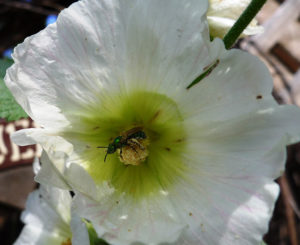 It’s not often I resort to a toxic chemical to get rid of insect pests in my garden. But when hollyhock weevils showed up again this year, I knew I had to take some drastic action.
It’s not often I resort to a toxic chemical to get rid of insect pests in my garden. But when hollyhock weevils showed up again this year, I knew I had to take some drastic action.
These weevils not only eat big gaping holes in the plant’s leaves, they use their long beaks for chewing into the flower buds so they can lay their eggs. Then the grubs feed on the seeds which can spell the end to having hollyhocks in the future.
Last year I spent many summer mornings picking these destructive pests off the plants and crushing them with my fingers. Damaged pods had to go, too.
So at the first sign of weevil damage this season, I decided to bring out the heavy artillery. I spent a lot of time researching pesticides before finding one that would take care of the weevils, but wouldn’t kill beneficial insects, too.
When using pesticides, it’s important to keep pollinators in mind. Bees are especially vulnerable to pesticides, and they need our help to keep their environment (and ours) safe and healthy.
Maintaining a healthy garden is the best way to avoid using pesticides in the first place. Start with clean soil, use adequate amounts of water without overwatering, and destroy unhealthy plants. At the end of the season, clean up garden debris so pests can’t overwinter.
Be observant in the garden and take action as soon as you spot a problem and before it can get worse. Some insect problems can be solved with several days of strong blasts of water from the garden hose.
Another organic method to get rid of insect pests is handpicking them off of plants and dropping them into a paper bag, trapping them with sticky traps or dishes of beer (or yeast-water mixture), or laying out boards for them to hide under at night and removing them the next day.
If pest problems persist, use the least toxic chemicals first, like neem oil, insecticidal soaps and repellants.
When you do decide to use a toxic pesticide, be thoughtful about it. Remember that fewer than 10 percent of insect pests warrant the use of pesticides. Decide if the plant damage is significant enough to call for using a pesticide in the garden.
Don’t grab the first pesticide you see. Read the label carefully to make sure it will treat the insect you’re after without causing harm to other insects or animals.
Follow all label directions precisely and wear the correct safety gear when applying. Use the right amount to spot treat the problem. Avoid indiscriminate spraying of all plants to solve one pest problem.
If spraying, do so at night when bees and other pollinators aren’t active in the garden. And when you’re done, store or dispose of containers properly.
Another method for dealing with insect pests is to take a wait-and-see approach. If you wait before using toxic chemicals, you’ll often see the problem isn’t as bad as you first thought.


